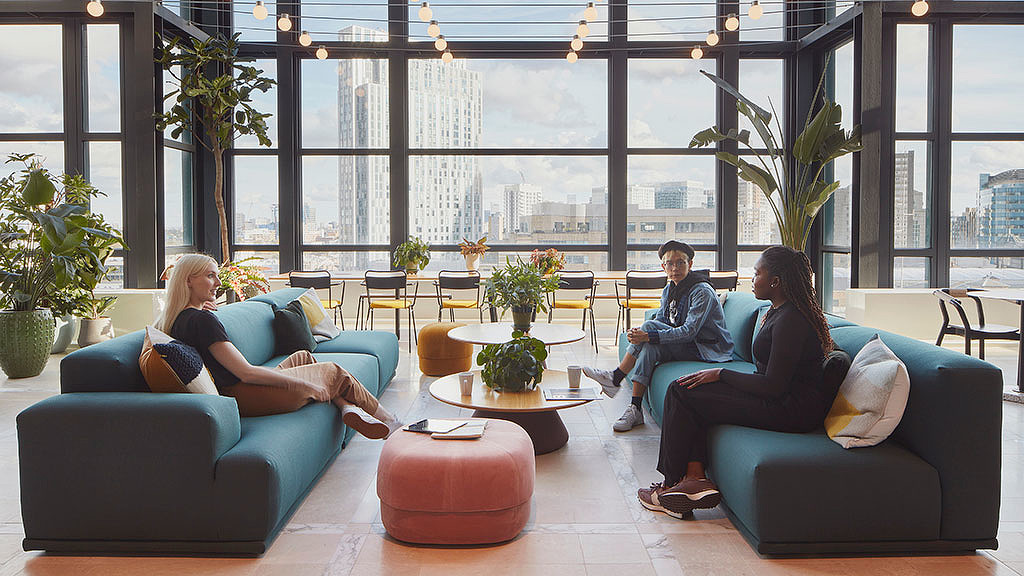3 Surprises Impacting the Return to the Office
February 13, 2023 | By Janet Pogue McLaurin
Editor’s Note: This blog is part of our blog series exploring insights from Gensler’s 2022 Workplace Survey findings.
Research often measures and confirms what we, as designers and strategists, may intuitively believe based on our experience and practice. As a researcher, I love uncovering surprises in the data that debunk common perceptions. These surprising truths often lead to a new understanding of how people work and what they value, as well as new insights on the built environment. In our latest workplace research study, we saw a number of unexpected surprises!
Here are the top three surprises uncovered in our research impacting the return to the office:
Surprise #1: A Shift in the Role of the Office
Gensler conducted 11 different workplace research studies during the pandemic to understand how work and employee expectations were changing and what it meant for the new role of the office. In our surveys, we asked office workers and senior leaders to choose their top five most important reasons to come into the office. Throughout the pandemic the top-ranked reason was to “work in-person with my team/colleagues.” This was the top reason in all six countries that we surveyed — the United States, U.K., France, Australia, India, and even China, where people had already returned after their first big wave of COVID cases. It was the top reason segmented by 10 different industries, as well as by generation.
Our latest U.S. Workplace Survey research was conducted in the late summer of 2022 as people were returning to the office. Like all of Gensler’s workplace research since 2008, we surveyed only office workers who spend at least part of their time in the office. This time, when we asked over 2,000 respondents to choose their top five most important reasons to come into the office, there was a sudden shift in the role of the office. The new top reason was to “focus on my work.” When we look at the top five or six important reasons, we see that people ranked access to technology, specific spaces, materials, and resources high, as well as scheduled in-person meetings with their team and sitting with their team. There was a shift from working with my team, connecting, and socializing to the broader purpose of simply getting their work done. Focus on my work was particularly important for the younger generations.
Surprise #2: Employees Say They NEED to Work in the Office More Often
In our latest North America surveys, conducted late summer 2022, U.S. employees report that they are spending 51% of a typical work week in the office. The balance of the week is spent working in other locations, business travel, coworking sites, third places, home. Time spent at the office varies by location, with government/defense and consumer goods industries spending the most time at the office and media and energy industries spending the least.
In the survey, we not only asked how much time respondents are currently in the office but also how much time they ideally need to work in their company’s office space to maximize their individual and team productivity. This was our second surprise: employees report that they need to spend more time at the office to maximize their productivity! And the top quartile of the U.S. innovative companies we surveyed say they need to work in the office 67% of the work week, which is the exact same percentage we measured before the start of the pandemic in February 2020.
We got a double surprise when we looked at productivity. Through the pandemic, people had reported that working from home was both efficient and highly productive. Our research hypothesis was that people would say that the office is more important for team productivity than individual productivity. But we found that both were equally important. In fact, U.S. office workers in high-performing workplaces report that they need to be in the office 72% of the work week to maximize individual productivity and 71% of the week to maximize team productivity. It was no surprise that employees who work in low-performing workspaces say they need to be in the office 6% less than they are currently coming in.
This begs the question of why. If employees say they need to work in the office to maximize individual and team productivity, why aren’t they coming into the office? What’s holding them back? We sense part of the answer may be why they are returning, as well as understanding what is working and what doesn’t when they do spend time at the office. Our last surprise may also be part of the answer.
Surprise #3: A New Mix of Experiences Would Bring Employees Back Even More
Finally, we wanted to explore what’s missing in the current workplace that would bring more employees back to the office. In a survey, it’s difficult to ask over 2,000 office workers across 10 industries what they wished they had at the office if they don’t know what’s possible. So, we described eight everyday experiences that people could easily relate with, ranging from a library to a coffee shop to a clubhouse. Respondents could select various experiences and toggle each to create a pie chart of their ideal mix of work experiences. As we analyzed the data, we saw some interesting patterns by industry and by generation.
However, we got a big surprise when we asked the question, “If your company provided your ideal work experience mix, would you be willing to coming to your company’s office more often?” In response, 42% say they would be willing to come in one more day/week, 17% say one more day/month, and 24% say they would be willing to return full-time! That’s 83% of employees who aren’t already full-time in the office. Younger generations report a greater willingness to return to the office for their ideal mix of work experiences.
Research on people and the built environment is an investment in our future. Research not only informs our projects and our work to make it better, but we can also learn from our projects to inform the next cycle of research. Surprises in research data are a gift as they can catalyze deeper conversations with our clients to understand how their employees work and the role that the built environment can play to not only support better work performance but enrich people’s lives and experiences. Surprises lead to deeper explorations and new insights, which fuel the power of design to imagine new possibilities!
For media inquiries, email .

